|
Author
|
Topic: What's it worth? SILTS project tail piece
|
Leah
New Member Posts: 4
From: Vienna, Virginia, USA
Registered: Sep 2002
|
 posted 09-03-2002 09:36 PM
posted 09-03-2002 09:36 PM
   
I stumbled upon this site in my search for trying to figure out the worth of something my husband bought at an auction (and he's not telling how much he paid for it!). What he will tell me is that this thing taking up space in the carport is called a SILTS project tail piece (?) and that it flew on at least six space shuttle flights. Apparently it's some sort of camera or something. Now, I'm not asking you to rat out a fellow collector, but what is this thing really worth? |
Robert Pearlman
Editor Posts: 42988
From: Houston, TX
Registered: Nov 1999
|
 posted 09-03-2002 09:59 PM
posted 09-03-2002 09:59 PM
   
I'm not quite ready to offer an appraisal, but for everyone's benefit, a little background (courtesy's NASA's Human Spaceflight website): Shuttle Infrared Leeside Temperature Sensing The SILTS experiment will obtain high-resolution infrared imagery of the upper (leeward) surface of the orbiter fuselage and left wing during atmospheric entry. This information will increase understanding of leeside aeroheating phenomena and will be used to design a less conservative thermal protection system. SILTS provides the opportunity to obtain data under flight conditions for comparison with data obtained in ground-based facilities. Six primary components make up the SILTS experiment system: (1) an infrared camera, (2) infrared-transparent windows, (3) a temper ature-reference surface, (4) a data and control electronics module, (5) a pressurized nitrogen module and (6) window protection plugs. These components are installed in a pod that is mounted atop the vertical stabilizer and capped at the leading edge by a hemispherical dome. (The SILTS pod replaces the top 24 inches of the vertical stabilizer.) Within this dome, the infrared camera system is mounted in such a way that it rotates to view the orbiter leeside surfaces through either of two windows-one offering a view of the orbiter fuselage and the other a view of the left wing. The camera is sensitive to heat sources from 200 to 1,000 F. The camera's indium-antimonide detector is cooled to cryogenic temperatures by a Joule-Thompson cryostat. The camera's field of view is 40 by 40 degrees. Its rotating prism system scans four 100-line fields each second, with a 4-1 interlace, resulting in a 400-line image. Each of the two infrared-transparent window assemblies consists of dual silicone windows constrained within a carbon-phenolic window mount. The windows and window mount assemblies are designed to withstand the entry thermal environment to which they would be subjected without active cooling. They are, however, transpiration cooled with gaseous nitrogen during experiment operation so that they do not reach temperatures at which they would become significant radiators in the infrared. A small thermostatically controlled surface between the two window assemblies provides an in-flight temperature reference source for the infrared camera. The pressurized nitrogen system comprises two 3,000-psi gaseous nitrogen bottles and all associated valves and plumbing. The pressure system supplies gaseous nitrogen to the cryostat for camera detector cooling, to the external window cavities for window transpiration cooling, and to pin pullers that initiate the ejection of the advanced flexible reusable surface insulation window protection plugs upon SILTS activation to expose the viewing ports and camera. The information obtained by the camera is recorded on the OEX tape recorder. The data, when reduced and analyzed, will produce a thermal map of the viewed areas. The SILTS experiment is initiated by the onboard computers approximately five minutes before entry interface, which occurs at an altitude of approximately 400,000 feet. The camera operates for approximately 18 minutes through the forward-facing window and left-facing window, alternating evenly between the two about every five seconds. After the six planned SILTS missions, an analysis of structural loads will determine whether the SILTS pod should be removed and replaced with the original structure or remain in position for other uses. The pod thermal protection system is high-temperature reusable surface insulation black tiles, whose density is 22 pounds per cubic foot. |
Robert Pearlman
Editor Posts: 42988
From: Houston, TX
Registered: Nov 1999
|
 posted 09-03-2002 10:15 PM
posted 09-03-2002 10:15 PM
   
So a few questions: - Did it come with any paperwork?
- How did the consignor come to own it?
- Can you share a picture?
|
Leah
New Member Posts: 4
From: Vienna, Virginia, USA
Registered: Sep 2002
|
 posted 09-03-2002 10:35 PM
posted 09-03-2002 10:35 PM
   
My husband got this through an auction, I'm not sure what paper work he has on it and he is going to take a picture of it in a few days when he can borrow a digital camera. Now this may be a paranoid question (keeping in mind that I am not a scientist, just a housewife) is something like this dangerous? I know that you all are serious collectors, so please excuse my postings if they are bothersome. |
Rodina
Member Posts: 836
From: Lafayette, CA
Registered: Oct 2001
|
 posted 09-04-2002 02:02 AM
posted 09-04-2002 02:02 AM
  
Some people on this site are serious about their collecting; but there are (mercifully) very few people who are just serious. |
Robert Pearlman
Editor Posts: 42988
From: Houston, TX
Registered: Nov 1999
|
 posted 09-04-2002 02:21 AM
posted 09-04-2002 02:21 AM
   
I cannot imagine any reason that the item would be dangerous -- NASA wouldn't allow its surplusing if it was. That said, I'm curious how or why NASA would relinquish ownership of a reusable piece of hardware. A picture will speak a thousand words -- as would a scan of any accompanying paperwork. |
Leon Ford
Member Posts: 309
From: Shreveport, LA, United States
Registered: Nov 1999
|
 posted 09-04-2002 05:08 PM
posted 09-04-2002 05:08 PM
   
This whole thing sounds pretty fishy. I think we should all stay out of this. We are not hearing the whole story on this item. Let the husband and wife work this all out by themselves. (If that is what is really going on with this thing.) As far as an estimate on the item goes: I'm sure that whatever your husband paid for the item, it was too much. |
Robert Pearlman
Editor Posts: 42988
From: Houston, TX
Registered: Nov 1999
|
 posted 09-04-2002 05:35 PM
posted 09-04-2002 05:35 PM
   
Leah sent photographs of her husband's auction find: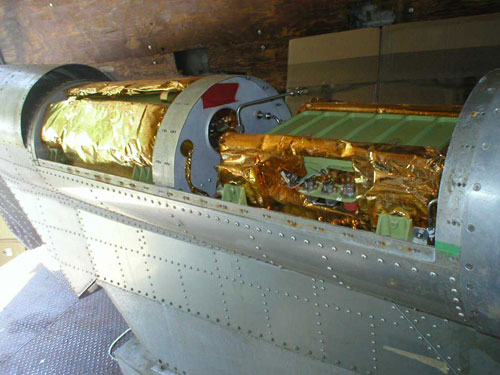 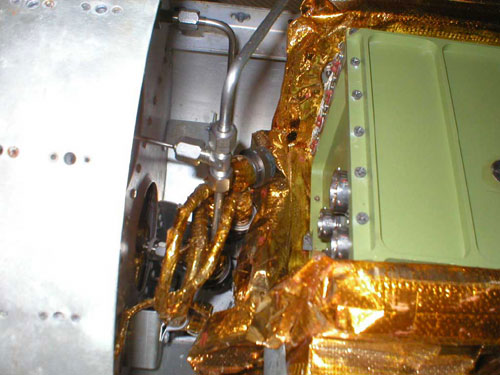
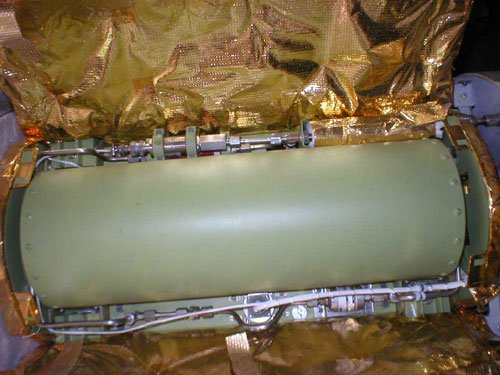
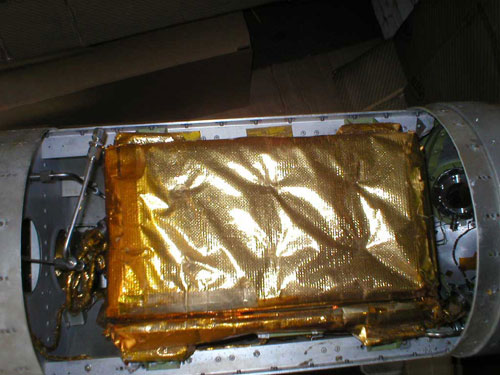
|
Robert Pearlman
Editor Posts: 42988
From: Houston, TX
Registered: Nov 1999
|
 posted 09-04-2002 05:36 PM
posted 09-04-2002 05:36 PM
   
And more...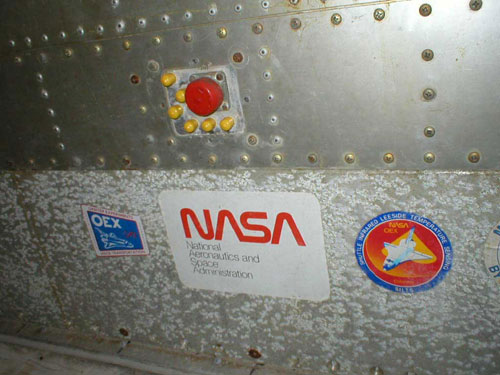 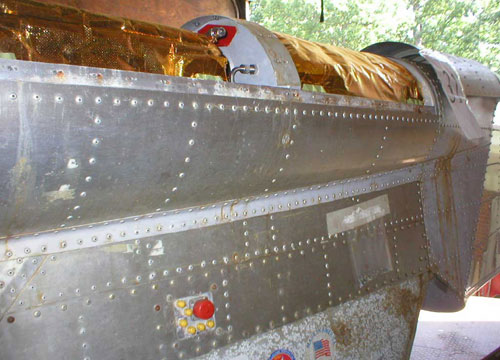
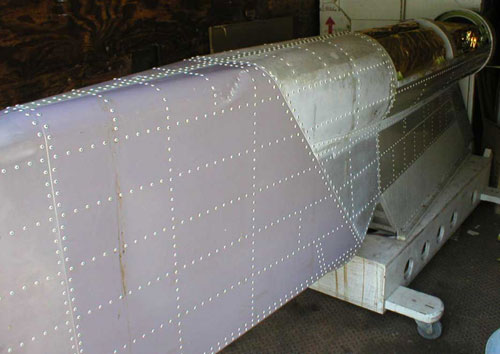
|
tegwilym
Member Posts: 2331
From: Sturgeon Bay, WI
Registered: Jan 2000
|
 posted 09-04-2002 05:44 PM
posted 09-04-2002 05:44 PM
   
Looks like one of those things that sits up on the top of Columbia's vertical stablizer.
(I guess it may have said that in Robert's message, but I just skimmed over it!). |
sts205cdr
Member Posts: 649
From: Sacramento, CA
Registered: Jun 2001
|
 posted 09-04-2002 06:49 PM
posted 09-04-2002 06:49 PM
   
Looks like a SILTS pod to me, maybe a prototype that was tested on an aircraft platform. Dunno what it's worth, but it sure is interesting! |
Ben
Member Posts: 1896
From: Cape Canaveral, FL
Registered: May 2000
|
 posted 09-04-2002 07:26 PM
posted 09-04-2002 07:26 PM
   
Guess one of mine would be that its unflown... test, or backup intended to fly but never did.The pod is still on Columbia, attached permanently, but it is an empty tube. Maybe this piece fits on, and the black tile-covered tube which is still on the orbiter fits over it? But that item, the flown one, it seems to me would not be an item NASA would just scrap, and with all the mechanisms still inside. |
Leah
New Member Posts: 4
From: Vienna, Virginia, USA
Registered: Sep 2002
|
 posted 09-05-2002 08:39 AM
posted 09-05-2002 08:39 AM
   
As I have said before, my husband bought this from an auction -- more specifically, a government auction, and he picked it up at a base, Langley, in Hampton Roads, VA. He has a receipt from GSA for it. If anyone has an idea of its worth or would be interested in purchasing it, please email me at jandzmom@aol.com. |


















